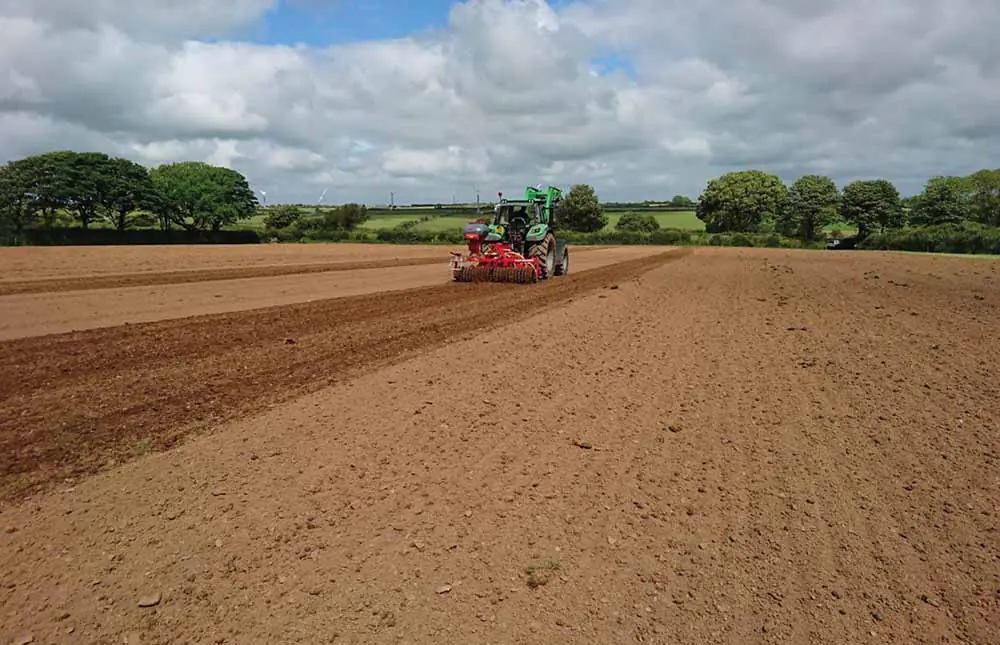Sowing grass on commercial landscapes
Specification for the seeding operation: The variation in site conditions and the proposed end uses make it difficult to offer a specification which satisfies all requirements.

The work will involve site clearance, minor and major upgrading, subsoil cultivation, drainage, general cultivation, blade grading, seed-bed preparation, turfing and/or seeding.
Site clearance
- All long grass and other surface debris should be either burned or otherwise disposed of and removed from the site;
- All obstructions within the site boundaries such as trees, shrubs and hedges should be removed from the roots and burnt on site, or disposed of to the contractors’ tips;
Any heavy foundation, such as roadways and other similar obstructions, should be cleared at this time and removed to a contractors’ tip.
Grading
- The site should be ploughed to the depth of the topsoil taking great care not to contaminate this with the subsoil;
- The soil should then be broken down using approved mechanical implements;
- Produce suitable levels by grading the entire surface by transferring topsoil in grade boxes or by blades to produce a surface which is friable and free from marked mounds or depressions;
- An absolute minimum depth of 100 mm, firmed true topsoil should be left covering the whole site on completion.
The above grading operation would be appropriate for sites whose topsoil depth and contours are reasonable, but it should be borne in mind that major subsoil grading does frequently have to occur when sites are re-contoured prior to achieving the required levels.
For this operation, the topsoil should be carefully stripped avoiding all contamination with subsoil and stored separately in mounds not greater than 1 m high prior to subsoil re-contouring. Only after suitable subsoil levels have been achieved, and allowing for settlement and drainage, should the topsoil be replaced and graded ready for seeding.
Seedbed preparation
- During the above preparations, all surface vegetation matter and rubbish should be removed and stones having a dimension of 20 mm or more should be collected and removed from the site;
- A suitable seedbed should be prepared using approved harrows and ring rollers as necessary to form a fine tilth for grass-seeding. The seedbed should be fine, smooth and evenly firm, but not over-compacted;
- On completion of the general preparations, level pegs should be set on a grid of 3 m centres followed by hand-raking and heeling on a small site and machine-levelling on larger sites. The contractor should ensure that this task is carefully carried out;
Shortly before seeding is carried out a fertiliser of approved specification should be evenly applied and raked into the surface. It is essential to use an approved applicator in order to give an even application over the site.
An appropriate pre-seed fertiliser for most amenity areas is: G1 Quick Start 6-9-6

Seeding
-
- The contractor should provide a certificate of origin giving details of purity, germination, year of harvest and country of origin, naming the individual cultivars which form the components of the mixture;
- During suitable weather the total quantity of seed required should be divided in half, each half being sown evenly by approved means in transverse directions;
- Sowing can be carried out in a variety of ways:
Whatever method is employed the aim should be to put the seed at a depth of approx 10 mm under the soil and ensure good seed-to-soil contact. Seed left on the surface is prone to drying out and seed buried too deeply will germinate but may never emerge. In certain circumstances, irrigation may be advised especially in prestige areas such as golf or bowling greens.


